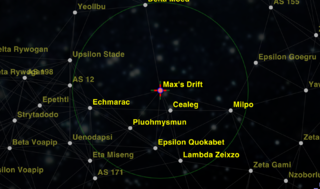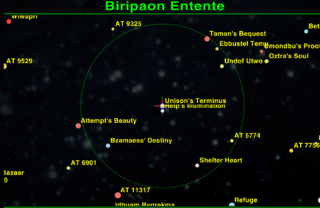Difference between revisions of "Cim's Oolite Galaxy Generator"
From Elite Wiki
(Updating BB links) |
Cholmondely (talk | contribs) m (Tagged as an External Programme) |
||
| Line 43: | Line 43: | ||
*[[User:Cim|Cim]] | *[[User:Cim|Cim]] | ||
| − | [[Category:Oolite]] [[Category:Oolite Development]] [[Category:Oolite utilities]] | + | [[Category:Oolite]] [[Category:Oolite Development]] [[Category:Oolite utilities]] [[Category:Oolite External Programmes]] |
Latest revision as of 20:15, 25 July 2024
Cim created this for his SOTL scenarios.
Contents
Overview
A windows programme for generating believable galaxies for the Oolite game code.
Detail
the map generator goes as follows, which is probably as good a recap as you'll get...:
- define systems, determine habitability for various species (which the planet colours should hint at)
- reverse-engineer home systems based on top habitability in the chart, except for humans who got in early
- add some early colonies for each species in two waves
- invent the galactic hyperdrive, start people meeting up and agreeing united species treaties, overall capital system in chart 3 (no homeworlds), embassy system in other charts (picked based on "least unfavourable")
- lots of cross-chart colonies taking systems suitable for their species that the native species didn't want
- a few passes of cooperative colonisation and some terraforming
- a bit more consolidation
- "not Thargoid" invasion wave from "outside", lots of destruction, increased militarisation, refugee colonies, etc. partial breakdown of central order
- that finalises the populations of the systems, and then it sets the economies based on habitability, resources, and history
- give each system influence points based on its population, and some historic bonuses, use those to spread out the various alliances from natural hubs until they meet at borders or run out of influence. Expanding influence past bottlenecks is extremely difficult.
- apply governments to regionalised systems based on history, some vague cultural preferences from the species, and influences from their regional leader. Certain systems end up at earlier stages being marked as "outsiders" and those tend to get the weirder government types.
- then go back and define the regions retrospectively based on their political coherence - is it plausible that the "lead" system is enforcing its will on the rest, or are the politics more split suggesting that this is an area bound together by economic or cultural/historic interests.
- fill in the governments for the non-regional systems
- certain systems near political alliances can end up in "Civil War" as pro- and anti- joining forces fight.
- other systems between alliances, especially in bottlenecks, can end up as "independent hubs"
- do a little bit of cleanup to make sure economic/political mismatches are sorted
- set up trade routes based on the imports and exports of the various economies, which the NPC freighters follow
- set up stability levels (influenced by population, economy, government, region type, history, etc.) which would, if there were any, determine piracy levels.
- fill in system names mostly based on the first species to inhabit (you'll see some partial constellations showing up in sectors around homeworlds)
- give the species names (they are, underneath, the Oolite species) and name the regions
- based on all of the above history, write the system descriptions
- finish off some other planetinfo.plist properties (which would at some point have included more main station types, reflecting the size and history of the system)
Some of the alliances probably are at war or at least cold war, I don't think I'd got as far as defining that much.
Download
Links
- Cim talks about this here (2022)
- Galaxy Seeds
- SOTL Exploration
- SOTL Altmap
- Cim

